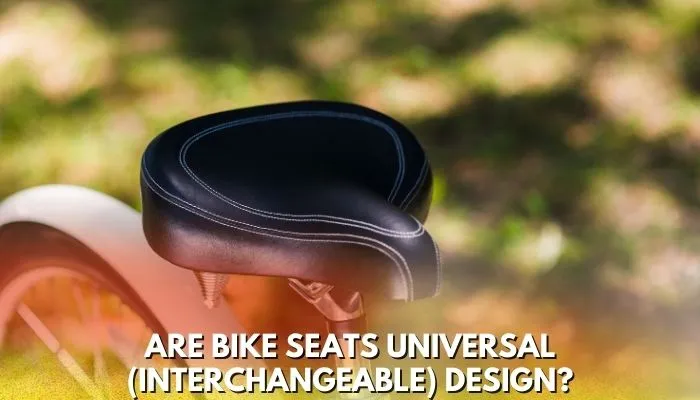Are Bike Seats Universal (interchangeable) Design?

The only exclusions are vintage bikes and pricey, unique seats. Moreover, make sure the seat you select is suitable for your body. The location where your bike seat makes the connection with the frame is a close point. A good one should have a major impact when you’re riding, whereas a bad one will just end in painful rides. Of course, your bike must fit the seat, no matter how good it is.
Are Bike Seats Universal
A large percentage of bike seats have a conventional two-rail structure, which allows for complete bike interchangeability. Due to the two corresponding rails on the bottom, you can instantly recognize a universal seat. The only exclusions are vintage bikes and pricey, unique seats. Moreover, make sure the seat you select is suitable for your body.
Since we can easily purchase a saddle off the market and mount it to our bikes, the standardized strategy works well for the majority of bike-riding enthusiasts. You will need to be educated because “it fits” and “absolutely perfect” are clearly somewhat different. We’re here to assist you with that, after all.
Table of Contents
Are Bike Seats Universal?

As long as the seat alone is fairly updated, bike seats are essentially universal and will fit any bike you own. You’re in paradise if you can find two rails that are 44 millimeters distant at their widest part and run from the nose to tail. Now, the vast majority of big companies implement this specification.
Unique seats can be seen on some bikes. It might not fit with your existing seat if the bike is extremely customized, such as a BMX, or it’s simply extremely old.
Then there are the incredibly precise I-Beam seats that work on a single rail instead of two. The practice of installing a bike seat from a distinct biking discipline, such as installing a race bike seat on a mountain bike, is not strongly recommended.
Are Seat Posts Universal?

Not all seats have seat posts. They are produced in various sizes that are fitted to various frames. In order for a post to accommodate your bike, the sizing must be correct, which is contrary to what you must do while searching for a compatible seat.
There are several exceptions to the rule, but 27.2mm is the standard size for a post. Every attempt at a thorough listing will become evident after a cursory glance at it.
It should be possible to acquire seat post sizing requirements from the manufacturer of any bike, and shopping on the internet makes it much more straightforward to find the proper post. If the data is unavailable, you are able to utilize a vernier caliper to get a reliable reading. It is not ideal to eyeball with a ruler since post sizes fluctuate by fractions of a millimeter. Yet, you can access the entire range of contemporary seats as far as the post is the right size.
- Exception (Special Cases)
As mentioned before, the typical rail system employed for bike seats only has a few variations. The majority of bike riders won’t see these. The topic of vintage bikes is significant. Prior to the current system’s widespread adoption, manufacturers preferred to develop their very own seat-attachment methods. There are very few if there are any, bikes of that vintage still in use nowadays outside of collector’s groups.
The other instance is likewise uncommon. There are some exorbitantly expensive seats that utilize a separate rail system and can have to get an adaptor to suit a normal seat post. It would be really lucky for you to come across one by accident, as they are infinitesimally uncommon.
Moreover, there are instances in which the seat and post are linked together as a single entity, most commonly on BMX bikes. In order to use these seats, you would need to fit the post to a frame since they are unsuitable with a conventional rail system.
Are There Bike Seats That Fit All People?

It’s important to select a bike seat that is the perfect size and style for your body and the kind of biking you do. We’ve already discussed whether different bike seats can fit various bikes, but it’s extremely important to do so.
Not all seats can accommodate all riders. The most crucial factor is size, but a rider’s preferences and requirements also are taken into account when selecting the ideal seat. While searching for an alternative bike seat, particularly if it’s your first time, you should evaluate every feature of the seat and evaluate how well it corresponds to your needs. The following list of some of the most crucial things to think about is provided in detail:
- Seat Height
There are numerous seat sizes available, but many infrequent riders are uncertain of what to look for in the right one. The seat you need will rely on your “sit bones,” which may or may not fit your stature.
A measuring pad may be provided in certain bike stores to help you out. You’ll need a precise measurement for the optimum fit if you’re going for the greatest performance.
It’s possible that you don’t need to measure precisely. Based on the measurements of the seat, you may roughly estimate things. Anything less than 100mm and more than 130mm is considered narrow and wide, respectively.
The majority of medium chairs will fall between 120 and 130 millimeters. It goes without saying that the greatest way to assess a seat is actually to sit in it. However, that may not always be a possibility. One of the standard bike saddle sizes fits the majority of individuals perfectly.
- Seat Design with Cutouts
Another issue to take into account is the design of the seat, with the forward-facing profile having an important influence. Your riding style will serve as your guide, but broadly speaking, the more upright you are while biking, the more contoured the seat should be.
The perineum and genitals are intended to be relieved of pressure through cutouts. Yet, some riders don’t need them, while the rest will discover that they reduce irritating pressure. It’s a matter of taste in both.
You will not have any issues with a seat as long as it doesn’t hurt to ride it, but aspiring professional riders should be especially aware of the limitations of their current seat.
- Materials for the Seat Cushion
There are numerous materials and amounts of padding available for bike seats. From traditional riveted leather seats with no cushion that are intended to adapt to the rider’s shape as they age to contemporary gel seats wrapped in synthetic fabric, they are accessible in an assortment of designs.
We’re back in the territory of subjective judgment. Natural leather seats are frequently extremely expensive, whereas synthetic materials are usually more affordable. The latter frequently have no cushioning at all and break in over time to become more pleasant. We’re back in the area of choices, but the rider feels a considerable improvement due to the cushioning and material.
Seats for performances generally have less cushioning than seats for casual events. Performance seats aren’t just for display; they’re also intended not to interfere with your movement while you’re biking, thanks to their minimalist appearance.
- Seating for Males vs. Seating for Women
Bike seats are not truly gender-neutral items. The design of the seat must be altered to accommodate somewhat different adjustments for the physical variations between the genders. Because of differences in hip position and width among men and women, there are various basic “styles” that are typically more acceptable for either sex.
While the seats of men tend to be longer and slimmer, those of women are quite often wider and shorter. The little physiological variations just need to be accommodated.
Consider the difference between the chairs for men and women as a significant suggestion. Some people will operate quite fine in either scenario or even perform much better in the seats based on their sex. Nonetheless, in general, it’s advisable to stay with seats that are made for your body shape and structure.
- The kind of biking (Casual, Road Racing, Mountain, Etc.)
Choosing the right seat requires taking into account your riding position. For instance, an overly padded seat composed of gel or memory foam is probably what a casual rider will like. In contrast to road or mountain bikes, most recreational riders sit down when riding. Although a comfortable seat is ideal for a relaxing ride, it won’t meet the requirements of those who want more performance.
Performance seats are intended to be compact and aerodynamic and to comfort the rider while they are seated. The majority of people discover that firmer cushioning works best for prolonged rides. There are also many variations that are included in the broad classification of performance seats.
For instance, if mountain biking is your primary task, you might want a seat that is a little bulkier and more sturdy, slightly more padded, and perhaps a little lower than road bike seats.
The same probably applies to other bicycle types: a road bike seat may be combined with a mountain bike saddle, and vice versa. But, depending on whether you’re riding on the road in an energetic (i.e., not upright) posture or when you’re hopping on and off the bike as you handle dirt trails, the technique your body reacts with the seat may vary.
The most crucial thing is that you use a bike seat that is adequate for your body type and the type of riding you do, as this is ultimately what makes a difference. As a consequence, trying out a few different seats before settling on one can be really helpful.
Also, when a product is branded as a “mountain bike seat,” it doesn’t indicate you can’t use it with a road bike (and vice versa). You can disregard the label if it is more convenient for you.
FAQs:
How do I determine which bike seat will fit?
It would help if you sat down on the foil or paper on a carpeting step and lifted your feet to resemble a rider. The two downturns left by your sit bones as you stand up should be noticeable. Your appropriate seat width can be identified by measuring the distance between both the depressions’ centers and inserting 25 to 30mm.
Are the seat posts on all bikes the same size?
In general, seat-post diameters are measured in steps of 0.2 mm and range from 22 to 35 mm. The majority of bikes, especially the higher-end models, have a standard size of 27.2 mm (1.07 in). 25.4 seat posts are repeatedly detected on BMX bikes. Larger diameters, such as 30.9 mm, are sometimes utilized in contemporary bicycles with sturdier alloy or carbon tubing.
Would a larger bike seat be preferable?
For lengthy rides or lazy riders where excess weight from more elements isn’t an issue, wider seats are desirable because they seem to be more relaxing. Thinner seats seem to be preferred during short efforts, such as racing, where comfort isn’t entirely unnecessary but is sacrificed in favor of other concerns.
Why are the seats on women’s bikes larger?
Female sit bones are often wider than male sit bones (about 1cm on average). You rest your body on these bones whenever you sit. In order to relieve pressure, women like to sit farther back on the seat than men do. As a consequence, women-specific seats have a propensity to be a bit wider at the back and shorter upfront than a universal seat.
Conclusion:
In light of this, you probably already know the answer if you are a novice curious about whether are all bike seats universal. Except if you have a bike that was bought in the distant past, many bike seats are replaceable and versatile. It’s frequently a worthwhile endeavor to test a new bike seat out before you buy it, just as a tiny beginner’s tip. You may test out the equipment before you buy it, which is one of the benefits.
